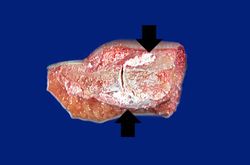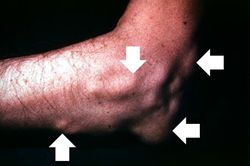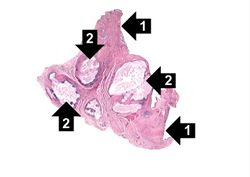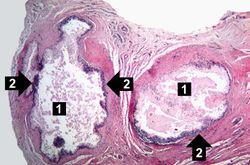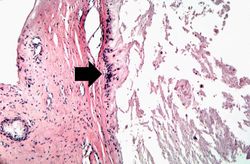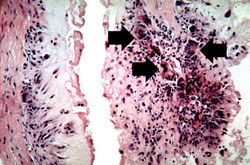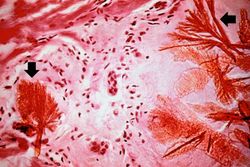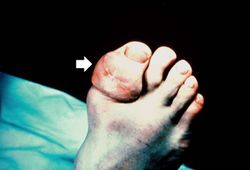Difference between revisions of "IPLab:Lab 5:Gout"
(Created page with "== Images == <gallery heights="250px" widths="250px"> File:IPLab5Gout1.jpg|This is a gross photograph of an index finger from a patient with gout. The finger has been sectione...") |
(→Autopsy Findings) |
||
| (10 intermediate revisions by 2 users not shown) | |||
| Line 1: | Line 1: | ||
| + | == Clinical Summary == | ||
| + | This patient was diagnosed with gout approximately 20 years ago. He has had numerous episodes of hot, painful, swollen joints involving the left knee, left ankle, and both first metatarsophalangeal joints. At the time of this admission the patient had increased serum uric acid values. In addition to his painful swollen joints, a gouty tophus was also present on the left arm. After remission of his acute gout flare-up the tophus was surgically removed. | ||
| + | |||
| + | The surgical specimen consisted of an elliptically shaped, mottled, yellow-white irregular hard mass, measuring 8.0 x 5.0 x 2.0 cm. in diameter. | ||
| + | |||
== Images == | == Images == | ||
<gallery heights="250px" widths="250px"> | <gallery heights="250px" widths="250px"> | ||
| Line 10: | Line 15: | ||
File:IPLab5Gout8.jpg|This is a gross photograph of a tophus on the great toe of another patient with gout (arrow). The healed surgical incision and the size of this tophus indicate that this was a long-standing problem for this patient. | File:IPLab5Gout8.jpg|This is a gross photograph of a tophus on the great toe of another patient with gout (arrow). The healed surgical incision and the size of this tophus indicate that this was a long-standing problem for this patient. | ||
</gallery> | </gallery> | ||
| + | |||
| + | == Virtual Microscopy == | ||
| + | <peir-vm>IPLab5Gout</peir-vm> | ||
| + | |||
| + | == Study Questions == | ||
| + | * <spoiler text="What are the two types of gout and which is more common?">The main type is primary gout which makes up 90% of all cases. In most cases of primary gout the specific enzyme defect is unknown but there is some enzyme abnormality which leads to hyperuricemia and symptoms of gout. In rare cases the specific enzyme defect is known, but gout symptomatology is the main clinical finding. | ||
| + | |||
| + | In secondary gout the cause of the hyperuricemia is known (e.g. leukemia, renal failure, Lesch-Nyhan syndrome).</spoiler> | ||
| + | * <spoiler text="What are the four stages of gout?"># Asymptomatic hyperuricemia | ||
| + | # Acute gouty arthritis | ||
| + | # Intercritical gout | ||
| + | # Chronic tophaceous gout.</spoiler> | ||
| + | * <spoiler text="Why is gout more severe in peripheral joints?">The decreased temperature accentuates the crystallization of monosodium urate (MSU).</spoiler> | ||
| + | * <spoiler text="What initiates the inflammatory reaction seen in the synovial membrane in gouty arthritis?">MSU crystals are chemotactic and they activate complement. This initiates a cascade of inflammatory events which leads to acute gouty arthritis.</spoiler> | ||
| + | |||
| + | == Additional Resources == | ||
| + | === Reference === | ||
| + | * [http://emedicine.medscape.com/article/329958-overview eMedicine Medical Library: Gout and Pseudogout] | ||
| + | * [http://www.aafp.org/afp/1999/0215/p925.html American Academy of Family Physicians: Gout and Hyperuricemia] | ||
| + | |||
| + | === Journal Articles === | ||
| + | * Harris MD, Siegel LB, Alloway JA. [http://www.ncbi.nlm.nih.gov/pubmed/10068714 Gout and hyperuricemia]. ''Am Fam Physician'' 1999 Feb 15;59(4):925-34. | ||
| + | * Pittman JR, Bross MH. [http://www.ncbi.nlm.nih.gov/pubmed/10208700 Diagnosis and management of gout]. ''Am Fam Physician'' 1999 Apr 1;59(7):1799-806, 1810. | ||
| + | * Qaseem A, Harris RP, Forciea MA. [http://annals.org/aim/article/2578528/management-acute-recurrent-gout-clinical-practice-guideline-from-american-college Management of Acute and Recurrent Gout]. ''Ann Intern Med'' 2016 Nov 1 10;7326/M16-0570. | ||
| + | |||
| + | === Images === | ||
| + | * [{{SERVER}}/library/index.php?/tags/784-gout PEIR Digital Library: Gout Images] | ||
| + | |||
| + | == Related IPLab Cases == | ||
| + | * [[IPLab:Lab 6:Rheumatoid Arthritis|Lab 6: Rheumatoid Arthritis]] | ||
{{IPLab 5}} | {{IPLab 5}} | ||
[[Category: IPLab:Lab 5]] | [[Category: IPLab:Lab 5]] | ||
Latest revision as of 19:55, 8 July 2020
Contents
Clinical Summary[edit]
This patient was diagnosed with gout approximately 20 years ago. He has had numerous episodes of hot, painful, swollen joints involving the left knee, left ankle, and both first metatarsophalangeal joints. At the time of this admission the patient had increased serum uric acid values. In addition to his painful swollen joints, a gouty tophus was also present on the left arm. After remission of his acute gout flare-up the tophus was surgically removed.
The surgical specimen consisted of an elliptically shaped, mottled, yellow-white irregular hard mass, measuring 8.0 x 5.0 x 2.0 cm. in diameter.
Images[edit]
This is a photomicrograph of a tophus that was fixed in alcohol prior to histologic processing. The alcohol fixation preserves the water soluble urate crystals within the tissue. Note the urate crystals visible in this photomicrograph (arrows). Also note the chronic inflammatory reaction in the background.
Virtual Microscopy[edit]
Study Questions[edit]
Additional Resources[edit]
Reference[edit]
- eMedicine Medical Library: Gout and Pseudogout
- American Academy of Family Physicians: Gout and Hyperuricemia
Journal Articles[edit]
- Harris MD, Siegel LB, Alloway JA. Gout and hyperuricemia. Am Fam Physician 1999 Feb 15;59(4):925-34.
- Pittman JR, Bross MH. Diagnosis and management of gout. Am Fam Physician 1999 Apr 1;59(7):1799-806, 1810.
- Qaseem A, Harris RP, Forciea MA. Management of Acute and Recurrent Gout. Ann Intern Med 2016 Nov 1 10;7326/M16-0570.
Images[edit]
Related IPLab Cases[edit]
| |||||
A tophus is a chalky accumulation of urate crystals found in the tissue surrounding a joint.
The normal fibrinogen level is 184 to 412 mg/dL.
Renal failure is the severe reduction of renal function and often leads to reduced urinary output.
